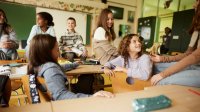How to Build a Strong Foundation for the Year
New elementary teachers can try these simple strategies to help students feel a sense of belonging in the classroom.
Your content has been saved!
Go to My Saved Content.Belonging is the extent to which people feel seen, heard, valued, and appreciated. Students need to feel they belong for learning to occur; belonging is a human need that impacts mental and physical wellness.
Nurturing a sense of belonging can help a new teacher and their students feel part of a school community and start the year on a strong path.
Fostering belonging
Build partnerships with students and families: This is ideally done by meeting before the first day of school. Practice deep listening to learn about students. Ask the following questions:
- What do you enjoy doing?
- What are you good at?
- What are you interested in learning about?
- What do you already know a lot about?
- What helps you feel like you’re part of a group?
- When do you feel like you belong and why?
Design the classroom for belonging: Students can sit in a circle the first week, to see, hear, and get to know each other. Then, small groups of three to four are ideal to develop friendships and collaboration. (At first, I initiate the groups by observing students who gravitate to each other and getting to know the students. Later, the groups can be heterogeneous so that students get to know all of their classmates throughout the year.)
I dedicate much of my wall space to meaningful student artifacts—to highlight strengths and identity. Gallery walks invite them to view the work and get to know each other.
Cowrite three to five norms with students: Norms are a way of knowing whether we belong and feel safe. Over several days, discuss what each norm looks, feels, and sounds like. Practice using the norms with collaborative activities in strategically developed small groups. I model using the norm or ask students to model it for classmates in a fishbowl.
Share stories: This helps everyone get to know each other and form a community. I begin by sharing a story about myself (either orally or with a text I’ve written). I provide scaffolds for brainstorming and composing so that students can create their own stories. Here are some topic ideas: a time you were proud, something you love to do outside of school, a favorite memory, a time when you tried something new.
As they work, I try to create another story, so that they see me as a writer and that I value writing. I offer choices for composing the stories (write, draw, talk, video) and for sharing (partners, small group, whole group). The article “How Storytelling About Learning Empowers Students” has more ideas.
Write dialogue journals with students: I’ve had huge success with students writing to me three to five times a week in dialogue journals; they write about whatever they choose, then I write back. I get to know students extremely well and can use what I learn to help nurture friendships and develop engaging activities.
One of the best ways to nurture belonging is to explore identity: Give students opportunities to explore and share who they are. They see that you value their unique identities and that it’s important to bring them into the classroom.
- Have students create self-portraits. Provide a variety of tools including crayons in different skin tones. Some students will draw their head and some will do their whole body. Encourage them to add details about parts of their identity and favorite activities, places, and loved ones (the video Mr. Melvin Makes a Folding Mask Self Portrait offers an idea).
- Compose “I Am From Poems.” I model with my own poem. I provide a graphic organizer and time to brainstorm ideas as a class or talk with a partner a student has a friendship or relationship with, an idea from Liz Kleinrock’s Start Here, Start Now, which also has graphic organizers. Students can write the poems like the model or they can compose in a way that’s meaningful to them (picture, video, lyrics, etc.). These focus on how each of us is unique and has our own sense of home, family, and who we are. Over time, students can add to the poems to include sensory details or more that they are learning or surfacing about themselves.
- Create Bio Bags, also from Start Here, Start Now. On the outside of a paper bag students draw or write about visible parts of their identity (clothing they wear, physical attributes they consider important, activities they enjoy or are good at, etc.). For the inside of the bag, students write, draw pictures, or find images and put these on slips of paper; these describe things people learn as they get to know them or when they choose to share with others. When students share their Bio Bags, they can select which of the pieces to share with others. As Liz Kleinrock notes, this is an excellent time to remind students not to make assumptions about each other, rather to listen and learn from each other.
When students know that you value their belonging, they feel seen and heard. You can intentionally personalize learning experiences for this particular group of students. Activities will be meaningful, and students will see themselves in the learning and feel engaged.
During my first year of teaching, as I nurtured community in my classroom, something unexpected happened—I, too, felt a sense of belonging as we formed our own special family. This helped me on hard days; teaching is not easy work, but if we focus on relationships, it makes a huge difference.
